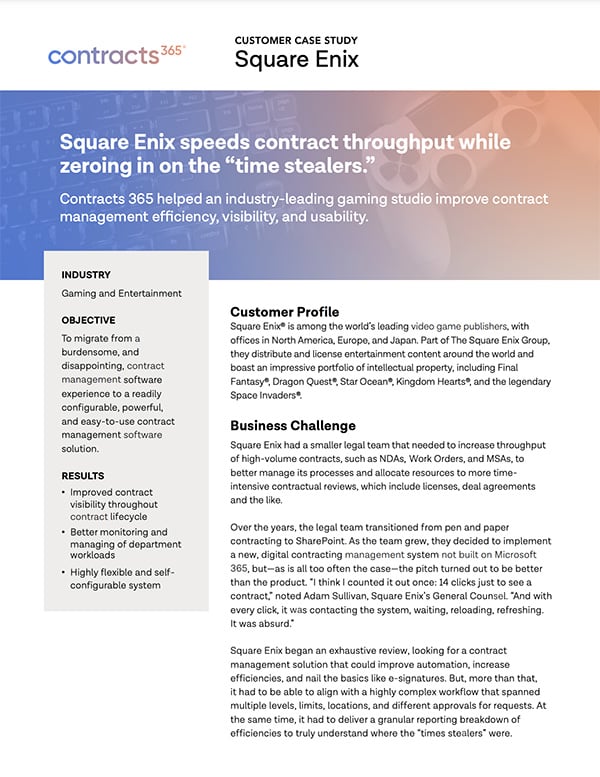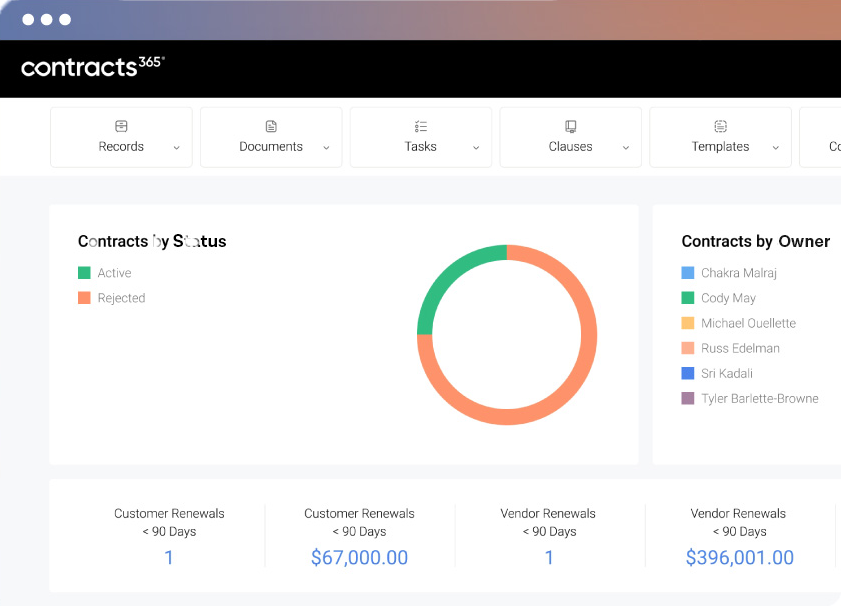Contract Managers: Here Are 4 Tools to Decrease Your Contract Cycle Time
December 27, 2018
•
6 min read
Dermot Whittaker
Contract managers are pressed on several fronts. As professionals, they need to uphold the contracting standards of their organization across dozens of agreement types. As workers in a busy department, they need to produce agreements efficiently. And as the primary contact for business users who need contracts to do their jobs, they are asked more often than they’d like: When will my contract be ready?
Decreasing contract cycle time – the time needed to turn a contract request into a signed agreement so business can proceed – is a common goal for contract and legal teams. Here are four tools that every contract manager can use to decrease contract cycle time: self-service contracts, clause libraries, contract playbooks, and workflow metrics.
1. Self-Service Contract Templates – Ready-to-Go Agreements with Approved Language
Self-service contract automation is a key part of higher end contract management software. As its name implies, a self-service process lets business users get a contract with minimal involvement from contract managers or legal personnel.
Here are two examples of self-service contracts.
- A Non Disclosure Agreement (NDA) limited to the standard terms and conditions of your organization. A business user and counterparty can complete the agreement’s required fields and submit for routine approval.
- Turnaround – quick because non-negotiable. In most cases, a defined, self-service NDA will move forward with no objection.
- Protections – The required fields ensure that essential information (name of counterparty, description of information covered) is recorded. And the terms and conditions, already approved by your legal team, are the ones that need to be there.
- A defined Sales or Purchase Agreement generated by a contract request form. Here the business user answers a series of questions and receives the right contract type containing the required terms and conditions.
-
- Turnaround – quick because a request receives the attention it needs based on complete business user input.
- Protections – Form-generated self-service contracts gather all the information needed to determine the correct contract type and review process. Dollar amounts determine whether competitive bidding, formal or informal, is required. Type of work (construction vs. IT, for example) signal to a contract manager whether other departmental approvals are needed. Getting all required information from the business user with a contract request form helps managers ensure that the right contract and process are used from the start, saving time in the long run.
Self-service contracts save time for any organization. The configuration of the contracts and request forms is flexible, getting contract requests started on the right foot.
2. Clause Library – Keep Contract Language at the Ready
Today a clause library typically refers to digital repository within dedicated contract management software where definitive contract language is stored. Your legal team, working with contract managers and the relevant department heads, enter the terms and conditions needed for any agreement that you plan to automate. This is not a one-size-fits-all effort. The legal team can provide alternate terms, fallback clauses (see below), and language relevant to specific lines of business, jurisdictions, and assessments of risk.
How is this a time saver?
- A clause library allows for automation. The relevant language is assembled into a contract automatically, based on a contract request and the required basic information. The language has been reviewed by legal already and remains consistent from contract to contract.
- A clause library saves legal time in crafting contracts. In cases where legal still needs to assemble contracts themselves, the library saves work. New in-house lawyers, paralegals, or outside counsel, can see what language has been approved for use by the organization and quickly assemble agreements using that language.
- A clause library empowers contract managers to assemble agreements where the business goals and risks are well understood. Contract managers can quickly deliver a sound contract, eliminating the scenario where the agreement is “stuck in legal.”
Clause libraries have the added benefit of putting everybody – legal, contract management, sales, purchasing – on the same page. The language protecting the organization is placed at the center of your contract creation process, reducing internal arguments with legal or purchasing about why such language is really needed. This saves time too; contracts that start out with the wrong terms and conditions are usually delayed when authorized signers see the errors and send them back for re-drafting.
3. Contract Playbook - Arm Negotiators with the Language They Need
Contract management software also includes a contract playbook. The playbook serves as a guide to attorneys and authorized negotiators during a negotiation. It tells them what terms they can flex on and, just as important, where they must hold fast. Playbooks usually offer a brief explanation of the importance of the terms and conditions in both a legal and business context. They anticipate, based on experience with similar contracts, where counterparty objections are likely to occur. And they signal where changes can be made by the lawyer or negotiator handling the contract and where they need higher approval.
A contract playbook also includes fallback clauses, approved substitute language that the legal team (working with contract professionals) has pre-approved to meet the common objections of a counterparty. The language in a fallback clause may add qualifications to the original clause that make it less objectionable to a counterparty. Sometimes a fallback clause simply offers an alternative (such as alternative site of governing law, or a choice of remedy for failure to deliver on time).
Using a playbook within contract management software, authorized negotiators can react to objections quickly and appropriately, either offering the fallback clause as a substitute, or making clear that the point is not negotiable. They can act confidently knowing that the negotiating paths and associated risks have been weighed already by the organization; indeed, an explanation of the rationale is usually included alongside the clauses themselves. This allows negotiations to proceed quickly without the interruption and delay of going back to legal for lengthy reconsideration.
The specific time savings of a clause playbook?
- A contract playbook informs the authorized negotiator of the rationale and strategy around use of approved language for the contract type in question. This makes it clear how and why the organization is taking the position described.
- A contract playbook quickly guides the negotiator to the fallback clauses for any particular objection and allows a substitution of that language to meet the objection. This saves time for an authorized negotiator, whether a new attorney, an outside counsel, or a contract manager.
- A clause playbook lets the negotiator insert the new language into a contract electronically without error-prone redrafting. This is quick and allows for new versions of the contract to be saved and sent back to a counterparty for review in minutes.
Most organizations that use playbooks find they reduce contract cycle times and increase contract volume with the same resources. In addition to time savings, contract playbooks keep negotiators to the positions that the organization’s legal team has agreed on. They provide the acceptable fallback position and keep authorized negotiators from going further than that on their own.
Read the Square Enix Case Study
Learn More
4. Workflow Metrics - Analyze Contract Cycles for Performance Bottlenecks
Review of contracts by legal, purchasing, specialized departments, and executives will always be needed for some contracts. Contract automation facilitates review and approval by people at the organization, especially for more complex, high-value contracts.
Contract automation is a system where contracts follow a prescribed workflow from one approver to the next. This saves the contract manager from having to manually (whether physically or through email) alert the next party that their attention to the contract is needed. By itself, that’s a time saver. It also makes workflow metrics possible.
Workflow metrics track the contract from request to internal review to final signature. The benefit is that the contract managers can see where in their cycle contracts spend the most time. Those bottlenecks have a reason – seasonal volume, limited staffing, inadequate background information, uncertainty about company procedures. Seeing where in the cycle bottlenecks occur is the first step toward addressing them. This in turn reduces contract cycles while improving the quality of operations.
Reducing contract cycles is a goal of contract managers. That does not have to mean cutting corners. With these four tools available within modern contract management software, contract cycles can be reduced by improving operational efficiency and making the contract process more effective across the organization.
Contracts 365 is end-to-end contract management software designed to integrate seamlessly with Microsoft 365. For more insights on how our contract management software can streamline your contract lifecycle management processes, reduce costs, and support your company’s bottom line, browse Contracts 365’s library of free resources or schedule a demo below to let us show you in person.
Subscribe and receive our latest blog articles in your work email.
We value your privacy. By subscribing, you agree to receive our newsletter. We’ll protect your personal data and use your email only for sending useful information. You can unsubscribe anytime. For details on data handling, please see our privacy policy.
Ready to Learn More?
Optimize your team’s contract lifecycle management with Contracts 365®
